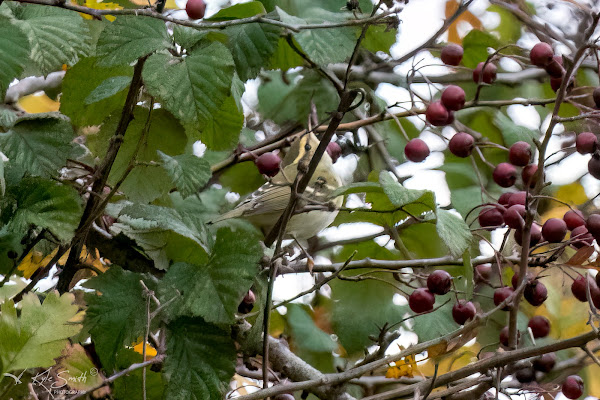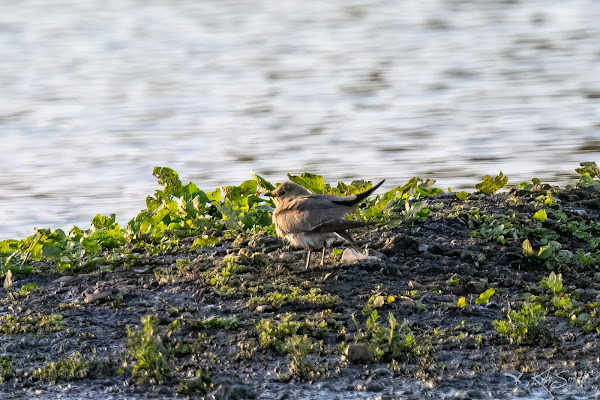Leaving RSPB Otmoor on Friday evening, Kevin Heath and I agreed to touch base in a couple of hours and decide where to bird on Saturday. Between times Kev had talked to his sister @hobbylovinglife (and her partner in crime Dean Reeves @worlebirder) and found out that they planned to try for the Richard's pipit reported over the last couple of days on the edge of the river at Awre, Gloucestershire. It sounded like a good idea, and I'd been hoping to meet Karen and Dean for some time – the pipit would also be a lifer for both of us.
Conditions were fine for the journey down but as we arrived and started putting on our boots the rain started to fall - this is when I discovered that I hadn't got my rain cover for my camera and lens and hoped it wouldn't be torrential. The rain fell steadily for 10-15 minutes and we saw flocks of linnet, some stonechats, starlings and goldfinches on the way down to the water's edge – the rain eased off slowly. We paused occasionally, scanning the hedges and fields for signs of pipits but none could be found. We climbed up onto the footpath and immediately I saw three cranes out in the river - we stopped for a look, noting two adults and a juvenile. As we watched, a kingfisher flew by and appeared to land over the brow and just out of view - Karen and I moved round to see if we could improve our line of sight but we couldn't relocate it - perhaps it hadn't stopped after all.

We looked up where the pin had been dropped and pushed on, seeing a couple of birders ahead and in the rough location. We stopped to watch some birds around some fencing and scrub noting reed bunting, stonechat, robin and wrens. As we walked on a pipit took to the wing, flying away and towards where the birders were standing. As it flew the pipit displayed some very unusual acrobatics as it appeared to feed on flying insects. The behaviour wasn't at all like usual mipit sightings / behaviour, and more like descriptions given in previous sightings of the Richard's pipit.
We gradually moved along the track, stopping regularly to view the hedges and grassy fields and to talk with one of the birders who was leaving in our direction - he reported that they had heard what they believed to be the target bird but had assumed it was coming from the bird they had seen us following. Stonechats, reed buntings and mipits were all showing but nothing resembling the Richard's pipit. A lone swallow flew along the grass field and away into the distance.
We reached the area where the pin had been dropped on Birdguides - we had heard that the bird had been feeding in the area between a large bramble bush and reeds on the riverbank. We set ourselves up, watching and listening - numbers of skylark joined the species already noted - we heard brief calls a couple of times which appeared to be the target bird but couldn't lock onto it for a confirmatory sighting. After some time, we decided to try a bit further down the field and towards a stubble field - Dean had plucked out a late whinchat along the hedge between the field behind and that beyond.
We scanned the stubble field and found a single redwing feeding with tits, a robin and a couple of blackbirds. In the hedge, on the stubble field ,and in a tree, the whinchat flitted about.
The wind was picking up and we could find only mipits so returned to the main area of interest - some skylarks and mipits went over and we began to wonder whether we'd get a good look at the target bird.
A pipit with what appeared to be a longer tail and darker flank went over and I snapped some more record shots - we reviewed the photos, but the side views were dark against the sky and the wing shots not conclusive on the back of the camera - very frustrating!
Later we were able to extract the photos and modify the light, finding that we had indeed captured a photo of our target bird and achieved a positive ID for Richard's pipit. Despite spending a significant time afterwards, we wouldn't get any repeat or better views.
The rain came again, followed by more wind, then sunshine - a continual change in conditions and not conducive to seeing any bird flights - the birds would likely be hunkered down. A rainbow appeared and looked attractive against the distant hills.
As the tide went out again, curlew started to return to the water's edge. We could see dunlin out in the exposed riverbed, and a flock of circa 100 black-tailed godwit spun around the opposite bank. Kestrels and buzzards cruised at distance.
We discussed what to do next, but I had to be back in Banbury as I was going out early evening - so we reluctantly left with only the briefest of views of the target bird. The sun appeared briefly, and I snapped a couple of the species showing along the hedgerow - the wind was picking up again and made it difficult on the return journey.
We climbed the last slope and reached the cars bidding farewell to Karen and Dean, happy with our day's birding, but slightly disappointed by our views - conditions hadn't been conducive but we had added another lifer.
Year List: 221
BirdTrack Record: https://app.bto.org/birdtrack/pubcon/shared?subId=SUB46085316























































